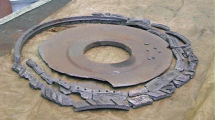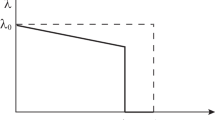Abstract
Various criteria of multiaxial fatigue fracture are studied for low-cycle fatigue (LCF); their generalizations are proposed for a very-high-cycle fatigue (VHCF) regime. The procedure of the stress state calculation is described for the compressor disk of the gas-turbine engine (GTE) in the flight cycle of loading and for the low-amplitude vibrations of the blades. The durability estimations of the disk operation are obtained for alternative mechanisms of LCF and VHCF using the calculated stress state and the models of multiaxial fatigue fracture. The results are compared with the data observed during operations.
Similar content being viewed by others
References
A. A. Shanyavskii, Modeling of Metal Fatigue Fracture (Monografiya, Ufa, 2007) [in Russian].
N. G. Burago, A. B. Zhuravlev, and I. S. Nikitin, “Models of multiaxial fatigue fracture and service life estimation of structural elements,” Mech. Solids 46, 828–838 (2011).
M. A. Meggiolaro, A. C. Miranda, and J. de Castro, “Comparison among fatigue life prediction methods and stress-strain models under multiaxial loading,” in Proceedings of the 19th International Congress of Mechanical Engineering COBEM 2007, Brasilia, DF, Brazil, Nov. 5–9, 2007.
D. F. Socie and G. B. Marquis, Multiaxial Fatigue (Society of Automotive Engineers, Warrendale, PA, 2000), pp. 129–169.
N. Shamsaei, M. Gladskyi, K. Panasovskyi, S. Shukaev, and A. Fatemi, “Multiaxial fatigue of titanium including step loading and path alternation and sequence affects,” Int. J. Fatigue 32, 1862–1874 (2010).
J. Lemaitre and J. L. Chaboche, Mechanics of Solid Materials (Cambridge Univ. Press, Cambridge, 1994).
J. L. Chaboche and P. M. Lesne, “Non-linear continuous fatigue damage model,” Fatigue Fract. Eng. Mater. Struct. 11, 1–17 (1988).
A. K. Marmi, A. M. Habraken, and L. Duchene, “Multiaxial fatigue damage modeling at macro scale of Ti6Al4V alloy,” Int. J. Fatigue 31, 2031–2040 (2009).
I. V. Papadopoulos, P. Davoli, C. Goria, M. Filippini, and A. Bernasconi, “A comparative study of multiaxial high-cycle fatigue criteria for metals,” Int. J. Fatigue 19, 219–235 (1997).
Ying-Yu Wang and Wei-Xing Yao, “Evaluation and comparison of several multiaxial fatigue criteria,” Int. J. Fatigue 26, 17–25 (2004).
G. Sines, Behavior of Metals under Complex Static and Alternating Stresses. Metal Fatigue (McGraw-Hill, New York, 1959), pp. 145–169.
B. Crossland, “Effect of large hydrostatic pressures on torsional fatigue strength of an alloy steel,” in Proceedings of the International Conference on Fatigue of Metals (London, 1956), pp. 138–149.
W. N. Findley, “A theory for the effect of mean stress on fatigue of metals under combined torsion and axial load or bending,” J. Eng. Ind., 301–306 (1959).
C. Bathias and P. C. Paris, Gigacycle Fatigue in Mechanical Practice (Marcel Dekker, New York, 2005).
N. G. Burago, A. B. Zhuravlev, and I. S. Nikitin, “Stress state analysis of gas turbine engine contact system “disc-blades”,” Vychisl. Mekh. Splosh. Sred 4 (2), 5–16 (2011).
V. Bonnand, J. L. Chaboche, H. Cherouali, P. Kanoute, E. Ostoja-Kuczynski, and F. Vogel, “Investigation of multiaxial fatigue in the prospect of turbine disc applications. Part II: Fatigue criteria analysis and formulation of a new combined one,” in Proceedings of the 9th International Conference of Multiaxial Fatigue and Fracture ICMFF9, Parma, Italy, 2010, pp. 691–698.
N. G. Burago, A. B. Zhuravlev, and I. S. Nikitin, “Very-high-cycle fatigue fracture of titanium compressor disks,” Vestn. Perm. Nats. Politekh. Univ., Mekh., No. 1, 52–67 (2013).
A. M. Mkhitaryan, Aerodynamics (Mashinostroenie, Moscow, 1976; PN, New York, 1972).
N. E. Kochin, I. A. Kibel’, and N. V. Roze, Theoretical Hydromechanics (Fizmatgiz, Moscow, 1963; Wiley, New York, 1964), Part 1.
Author information
Authors and Affiliations
Corresponding author
Additional information
Original Russian Text © N.G. Burago, A.B. Zhuravlev, I.S. Nikitin, V.L. Yakushev, 2016, published in Matematicheskoe Modelirovanie, 2016, Vol. 28, No. 2, pp. 53–64.
Rights and permissions
About this article
Cite this article
Burago, N.G., Zhuravlev, A.B., Nikitin, I.S. et al. A study of different modes of fatigue fracture and durability estimation for compressor disks of gas-turbine engines. Math Models Comput Simul 8, 523–532 (2016). https://doi.org/10.1134/S2070048216050070
Received:
Published:
Issue Date:
DOI: https://doi.org/10.1134/S2070048216050070




